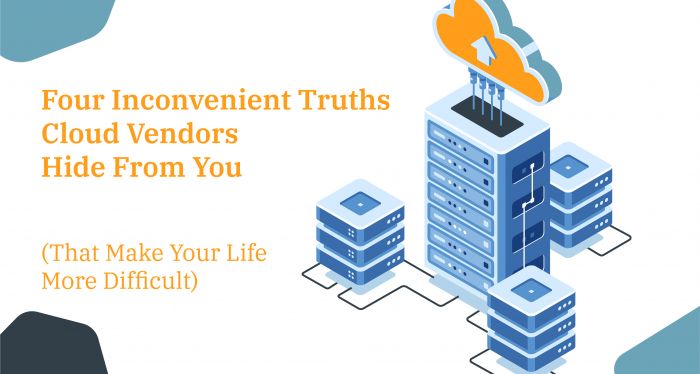Four Inconvenient Truths Cloud Vendors Hide From You (That Make Your Life More Difficult)
Views, News & more

Cloud migration is the future right? Well, yes, but it doesn’t mean that it solves all your problems straight away. It also doesn’t mean that there aren’t drawbacks. Below we’ll take a look at some of the disadvantages to cloud migration that vendors tend to leave out of their sales pitches.
1. Cloud is only PART of the solution.
Once you have completed your migration to the cloud, you may find that you come across a few stumbling blocks. Your employees’ expertise is one such stumbling block. Businesses often find that their staff are more used to maintaining their in-house infrastructure and hardware and struggle to get their heads around the mountain of vendors and technologies they are now expected to oversee. There’s no doubt that you will need to train staff to equip them with the skillset they will now need to manage the migration to the cloud.
An when it comes to equipment, following a cloud migration, you’ll be left with a legacy kit that you no longer have a use for. It can be challenging to know what kit you need to keep hold of and what you can recycle, or adapt to a new use (storage, etc.).
Can your business still run with the risk of outages? This is another way in which cloud computing is only part of the solution. If you lack a super reliable and fast internet connection at your business premises, you may find that your cloud services are enduring prolonged or frequent outages of the kind you will have never had to live with previously.
This year’s RightScale State of the Cloud survey found that users of the cloud are aware that they are losing money following their migration. The average waste? 30 percent. So, far from being the cost-saving solution it is marketed to be, the cloud can continue to cost you more money than it needs to. Some 58 percent of cloud users surveyed said that they plan to focus on cloud optimisation in the coming year as a way of solving this problem.
2. There’s not just one cloud.
In fact, there are multiple clouds and multiple software-as-a-service offerings. And even if you choose to use one particular IaaS/PaaS service for now, you will still need the flexibility to change to something else later.
Businesses often opt for a multi-cloud strategy in order to try to avoid the pitfalls associated with a single cloud environments, such as outages. However, this brings with it its own complexities, such as multiple service level agreements and varying levels of control over backend infrastructure for example.
3. Moving everything to the cloud can be a lot of work.
Performing a complete cloud migration in one go presents an enormous challenge. In fact, it might be more practical to migrate data to the cloud, and to leave some stuff where it is. If you do plan to move everything to the cloud, you don't have to do it yet. You may prefer to stagger any migration, accommodating your usual upgrade cycles. This might save you cash and also allow your team to upskill over a period of time that is conducive with the migration.
4. It’s not all about location, location, location.
Some cloud vendors would have you believe that migrating to the cloud is all about moving the data away from your premises, freeing up time, cash, space and expertise for other tasks. Although cloud migration does remove the need to store data on site, it also contributes to much of the anxiety about security that so many cloud users still have.
According to the State of the Cloud survey, 77 percent of cloud users are concerned about security, with 29 percent claiming security is a significant challenge.
Conclusion
Although it seems to be the obvious next move for many businesses, cloud migration doesn’t come without some drawbacks that vendors are unlikely to flag up. It’s up to IT managers or business owners to decide whether cloud migration is right for their unique requirements and to ensure that they put in the required hard work needed to optimise its use once migration has taken place.
Hybrid cloud services are becoming extremely popular as a way of maintaining a better level of control, while still making use of cloud technology. Teaming up with a cloud service partner will also help to minimise the disruption to your business while offering a single point of contact for all your cloud services, regardless of the number of service providers you deal with.
Cloud is probably the future ... but we don’t think it needs to be quite so complicated.
(Image: Background vector created by fullvector - www.freepik.com)
Get in touch
020 7847 4510
We may process your personal information in order to send you information you request, measure and improve our marketing campaigns, and further our legitimate interests. For further details, see our privacy policy.
Contact us
-
- Head Office:
- hSo, 50 Leman Street, London, E1 8HQ
- Switchboard:
- 020 7847 4500
- Support (24x7):
- 0333 200 3337
- support@hso.co.uk
- Marketing & Sales:
- 020 7847 4510
- info@hso.co.uk

















